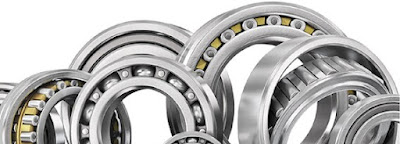The logic behind bearing references 1.
Bearing references have been a staple in many industries, particularly in engineering and construction. These references are essential for correctly identifying a bearing's type, size, and characteristics, allowing engineers and technicians to select the right bearing for their application. They also help in identifying the right replacement parts when a bearing needs to be replaced. Beyond their practical applications, bearing references can also offer valuable insights into how bearings are made and what makes them suitable for different applications. In this blog post, we will explore the logic behind bearing references in detail, providing a comprehensive guide to understanding bearing markings, designations, and classifications. We will also discuss the different types of bearings and their applications, and provide helpful tips for selecting the right bearing for your specific use case. Whether you are an engineer, technician, or simply someone interested in the science behind bearings, this post will provide valuable insights into how bearing references work and why they matter. So, without further ado, let's dive in and explore the world of bearing.
1. Bearings are used to reduce friction and improve efficiency in machines.
The use of bearings is an essential aspect of machine design and operation in various industries. Bearings are used to reduce friction and improve efficiency in machines. They are specialized components that support the load and enable rotation of one part relative to another in a machine. Bearings are typically made of materials like steel or ceramic and are specifically designed to withstand high loads, pressure, and temperatures. They utilize a variety of mechanisms, including rolling elements like balls or cylindrically shaped rollers, to reduce friction and support weight. Without bearings, machines could not function correctly, and their performance would suffer. The importance of bearing selection and maintenance cannot be overstated, as it can make a significant difference in the lifespan and performance of machines. Bearing failures can result in costly damage to equipment and, in some cases, even cause safety concerns. By understanding the logic behind bearing references, machine designers can make informed decisions for selecting and maintaining bearings, thus ensuring optimal performance and efficiency.
2. Properly referenced bearings help ensure proper installation and maintenance.
Properly referenced bearings play an integral role in ensuring proper installation and maintenance of a system. Bearing reference standards have been defined by accredited organizations, such as the International Organization for Standardization (ISO), to provide guidelines and procedures for manufacturers and users of bearings. These standards specify technical requirements for bearing dimensions, tolerances, load ratings, and accuracy of rotation, among other parameters. By referencing these standards, users and manufacturers can ensure the interchangeability and compatibility of bearings from different suppliers. Moreover, referencing these standards also helps manufacturers in producing bearings that meet the requirements of their customers and ensures safe and reliable operation of the whole system. Therefore, it is crucial to use properly referenced bearings to maintain and optimize the performance of the equipment and prevent premature failures.
3. Bearing references consist of a series of numbers and letters that indicate size, type, and other specifications.
The identification and reference of bearings is pivotal in the proper selection and utilization of these essential mechanical components. Bearing references consist of a series of numbers and letters that indicate size, type, and other specifications. These codes are used to differentiate between various bearing components and ensure that the correct part is used in a given application. The logic behind bearing references can be complex, but with a basic understanding of the code structure, users can quickly identify the components they need. There are several different types of bearings, each with its own reference system, and it is important to be familiar with the codes used for each type. Proper bearing selection and maintenance help to ensure equipment reliability and longevity, making a thorough understanding of bearing references a must-have for anyone working with mechanical systems.
4. Understanding bearing references can help prevent costly mistakes in replacement and maintenance.
Bearing references play a crucial role in the proper maintenance and replacement of bearings in industrial applications. Understanding these references can help prevent costly mistakes and ensure that the right bearing is used for the job, ultimately extending the life of your equipment. The format of bearing references can vary by manufacturer, but typically include information such as the bearing type, size, and series. Additionally, references may include important details about the bearing's design, materials, and load capacity. By taking the time to understand these references, maintenance professionals and engineers can make better-informed decisions when selecting and servicing bearings, ultimately improving the safety and efficiency of industrial operations. In this document, we will explore the logic behind bearing references, why they are important, and how to decipher them.
5. Consult with a bearing expert or manufacturer to ensure the correct referencing and installation of bearings.
Proper referencing and installation of bearings play a vital role in ensuring the performance and longevity of industrial machinery. To achieve this, it is important to consult with a bearing expert or manufacturer who has the necessary expertise and knowledge to provide guidance on the appropriate referencing and installation techniques. This step is critical in bearing-related applications and can prevent premature machinery failure, which can lead to costly downtime and revenue loss. A bearing expert or manufacturer can help you identify the correct bearing type, size, and material for your machinery and provide guidance on proper installation procedures. By ensuring that you have the right bearings installed correctly, you can prolong the life of your equipment and minimize the risk of unplanned downtime. Therefore, it is highly recommended that you seek expert advice to ensure the proper referencing and installation of bearings.
In conclusion, bearing references are a crucial yet often overlooked aspect of engineering, architecture, and construction. While there may be variations in the way this data is presented or documented, it's clear that a standardized system for bearing references is necessary to ensure safety, accuracy, and efficiency. By understanding the logic behind bearing references and adhering to established protocols, professionals in these fields can work together to create reliable and durable structures that meet the needs of communities around the world.




Megjegyzések
Megjegyzés küldése